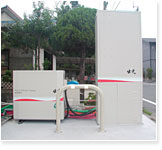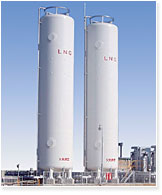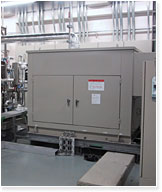|
|

|
|
HOME > New Challenge
|
|
|

|


 |
The heart of this energy efficient and environmentally friendly energy system is a fuel cell that drives a chemical action between hydrogen extracted from environmentally friendly LP gas and oxygen in the air in order to create electricity and hot water. The generated electricity can be used to light and power our homes, and the hot water can be used for baths and floor heating system. Astomos Energy aims to establish sustainable and environmentally friendly communities through the promotion of its fuel cell systems, and conducts verification tests in households around the country.
|

|

 |
Most of our natural gas, which mainly consists of methane, is imported from Indonesia, Malaysia and other countries in the form of LNG (Liquified Natural Gas). Similar to LP gas, this is a clean and environmentally friendly form of energy, and can be found in many regions of the world other than in the Middle East. To meet a diverse range of needs relating to energy and environmental conservation, Astomos Energy continues to develop solutions and technologies for utilizing gaseous forms of energy including not only LP gas, but LNG as well. By doing so, Astomos Energy is committed to establishing new foundations for its business as a total energy company.
|

|

 |
DME is produced from natural gas or coal, and is qualitatively similar to LP gas, it is easy to handle, contains almost no impurities such as sulphur, and burns well. For this reason, DME has attracted much attention as a clean form of energy for the future that can be utilized in a wide range of applications. Many Japanese organizations are actively engaged in studies for its utilization and R&D in all areas ranging from production to distribution. Astomos Energy participates in projects for enhancing its distribution infrastructure and promoting its utilization. We also conduct cogeneration verification tests as part of our R&D efforts to develop utilization technologies.
Cogeneration systems: Systems that burn fuel to generate electricity and effectively use the resulting heat for producing hot water or for heating systems.
|

|
|

|
|
|
 |



